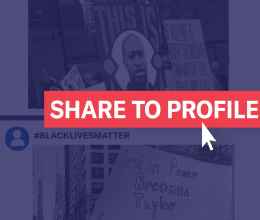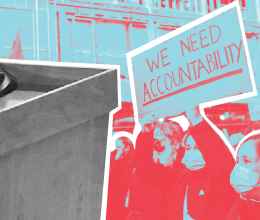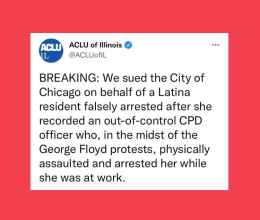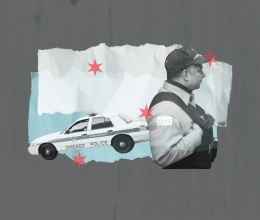
By: Joshua Levin, Staff Attorney
Data reported by the Chicago Police Department (CPD) to the Illinois Department of Transportation (IDOT) about police traffic stops in 2021 confirm what many people of color in Chicago have experienced throughout their lives: Chicago police do not enforce traffic laws fairly or equitably. Black and Latinx drivers in Chicago are stopped and searched at far higher rates than white drivers. Chicagoans deserve to know why drivers of color are being disproportionately policed and what City officials plan to do about it.
CPD’s data—which police departments are required by Illinois law to collect—shows an alarming trend. In recent years, CPD has massively increased traffic stops. From 2015 to 2021, CPD’s total number of traffic stops skyrocketed from 86,000 to nearly 378,000—a more than four-fold increase. Even more alarming, CPD has targeted this policing tactic at people of color. Last year, Black drivers were more than 5 times more likely to be stopped by CPD than white drivers. And Latinx drivers were nearly 2.5 times more likely to be stopped. Two out of three people pulled over by CPD last year were Black, even though Black people make up just 1/3 of the city’s drivers.
When people of color are pulled over by CPD, it is primarily not for moving violations that endanger public safety, like excessive speeding or reckless driving. Rather, the data shows that the vast majority of CPD’s stops of people of color are for technical equipment and licensing violations, like having expired tags or a license plate not adequately lit. As study after study on traffic stops in other states has shown, drivers of color are far more likely to be stopped for these minor infractions than white drivers.
CPD’s data also shows racial inequality in how CPD officers treat drivers after they are pulled over. Chicago police subjected drivers of color to invasive vehicle searches at far higher rates than white drivers, even though drivers of color were less likely to have contraband found in their vehicles. Black drivers stopped by CPD were more than 5 times more likely to be asked to consent to a search of their car than white drivers. Latinx drivers were nearly 4 times more likely. However, assuming CPD correctly reported its data, officers were 23% more likely to find contraband in the cars of white drivers than Black drivers, and 12% more likely to find contraband in the cars of white drivers than Latinx drivers.
When asked about the racial disparities, CPD recently stated that its traffic stop practices are “informed by crime data and calls for service.” In 2018, CPD Director of Community Policing Glen Brooks stated: “When we have communities experiencing levels of violence, we do increase traffic enforcement.” So, CPD’s explanation appears to be that its traffic stop practices are aimed at fighting crime. But the data tells a different story. It shows that CPD’s traffic stops are ineffective at ensuring public safety and fighting crime. Based on the data reported by CPD, out of all Black drivers stopped by Chicago police in 2021, just half of 1% had contraband in their vehicle. Even factoring in the traffic citations associated with gun charges against Black people that CPD apparently failed to report, over 99% of CPD traffic stops of Black drivers did not result in a gun charge or confiscation.
The racial inequality in CPD’s traffic practices is especially extreme in Chicago’s predominantly Black and Latinx neighborhoods. This is where CPD’s traffic stops are the most highly concentrated. Take Austin for example. CPD conducted 1.7 times more traffic stops in the predominantly Black neighborhood of Austin than in the majority-white Near North Side, even though the Near North Side’s driving population is almost 4 times greater than Austin’s.
The data shows no traffic safety justification for CPD’s disproportionate focus on Austin. Nor does it show a public safety justification for the extreme racial disparities in who gets pulled over there. In Austin, Black drivers were nearly 10 times more likely than white drivers to be stopped by police and more than 1.4 times more likely to be asked to have their car searched, even though Black drivers in Austin were nearly four times less likely to have contraband found in their cars than white drivers. And CPD reported that 98% of all stops of Black drivers in Austin ended in a mere verbal warning. So while CPD may assert that targeting predominantly Black and Latinx neighborhoods for vehicle stops is a means of combatting violence, CPD’s own data shows this tactic does not result in meaningful crime reduction.
The longstanding racial inequality in CPD’s traffic practices causes serious, ongoing harms. Because Black and Latinx drivers are more likely to be stopped by police, they are more likely to experience invasive questioning, searches, humiliation, and, all too often, tragic violence at the hands of police. A recent study by the City of Chicago Office of Inspector General found that, among CPD traffic stops that involved an officer using force, 87.2% of such uses of force were against Black people. Even when stops do not result in violence, they cause damage. The disproportionate, over-policing of drivers of color leaves many Black and Latinx Chicagoans feeling like perpetual suspects, rather than equal community members. This deepens distrust and fear of the police.
In a city struggling to build public trust in the police department, particularly in Black and Latinx communities, City officials must study CPD’s traffic stop data—embrace it as a tool to solve this urgent problem—and then explain their policy choices. The burden is now on City and CPD leaders. They must explain why any CPD traffic practice that has a racial disparity is necessary for public safety. In particular, we call on City officials to answer these critical questions:
- What CPD policies or practices have led to the more than four-fold increase in traffic stops since 2015?
- What policies or practices does CPD have in place that are causing the persistent racial disparities in traffic stops and searches?
- What changes will the City make to those policies or practices to reduce the racial disparities?
- Why have the racial disparities in CPD’s traffic stops persisted over the 17 years that this data has been collected?
- What steps have other jurisdictions taken to reduce racial disparities in traffic stops, and can the City make similar reforms?
- How does the City plan to incorporate impacted communities’ input in developing reforms that will reduce the racial disparities?


